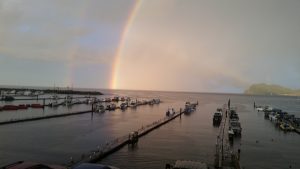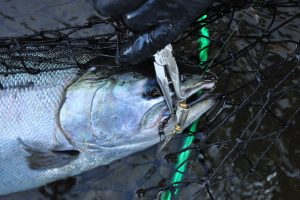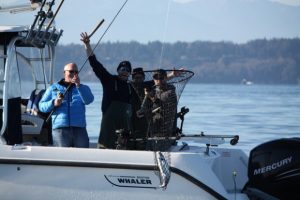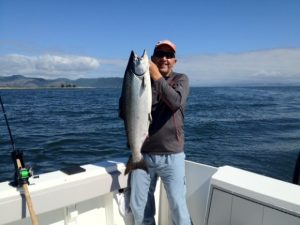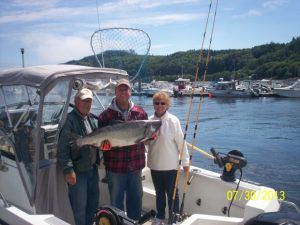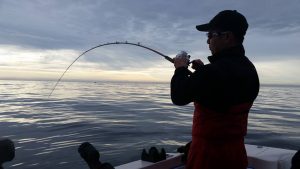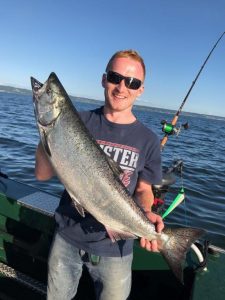Preliminary salmon fishing options come to light, and Puget Sound anglers could see more time on the water Leave a reply
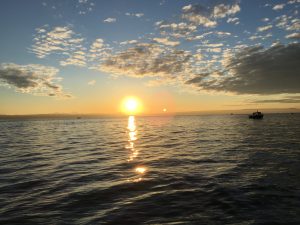
The sun rises over the horizon at Midchannel Bank off Port Townsend last weekend as anglers seek out hatchery chinook salmon.
State fisheries and Pacific Fishery Management Council developed ocean salmon fishing options, and some early work was made for Puget Sound and Strait of Juan de Fuca fisheries at meetings that ended last week in Sonoma, California.
Chinook and coho returns are still in the recovery phase after several grim years due to poor ocean conditions and drought-like weather.
”We are working very hard on the (NOF) process and have the commitment from our co-managers to have a better understanding of salmon issues and to work together on getting to an agreement even though we have our own differences,” said Ron Warren, the WDFW assistant director.
In Puget Sound, anglers will see somewhat negative or at least cautious views about chinook and coho returns. The Strait of Juan de Fuca and Snohomish coho returns have an “overfished” status, meaning that spawning escapement for these two stocks were below levels of concern for the past few years requiring a cautious approach to 2018 fisheries. However, in general the 2018 forecasts for Puget Sound chinook and coho look much better.
There are some very early concepts of sport salmon fishing possibilities that were drafted by state fisheries and reflects a “wish list” of what could happen when final seasons are approved in early April. All of the fisheries would need to be approved by various agencies as well as tribal co-managers.
One highlight if all the stars align would be Puget Sound coho fishing in late-summer and early-fall, which has faced some tough times in recent years due to very poor returns.
In the Strait of Juan de Fuca, Sekiu (Marine Catch Area 5) and Port Angeles (Area 6) could see a hatchery coho season from July through mid-September.
In San Juan Islands (Area 7) the early proposal has a non-select coho fishery from July through September. The east side of Whidbey Island (Areas 8-1 and 8-2) for the moment has a proposed non-select coho fishery in August and September.
In northern Puget Sound (Area 9) the early proposal shows a hatchery coho season from mid-July through September. Central and south-central Puget Sound (Areas 10 and 11) could be non-select for coho from June through April of 2019.
In Hood Canal (Area 12) there is a non-select coho proposed from July through April 2019. Southern Puget Sound (Area 13) could be open for hatchery-marked coho from May through April 2019.
For hatchery-marked chinook, a proposed fishery Sekiu and Port Angeles would see it open from July through mid-August. Then reopen at Sekiu mid-March 2019 through April and at Port Angeles from March 2019 through April 2019.
The San Juan Islands could be open for hatchery-marked chinook in July and December through April 2019, and non-select chinook from August through September.
The east side of Whidbey Island could be open for hatchery-marked chinook from December through April 2019. There would also be a summer-time terminal salmon fishery at Tulalip Bay.
Northern Puget Sound is earmarked for the normal mid-July through mid-August hatchery-marked chinook fishery as well as from December through April 2019.
A central Puget Sound hatchery-marked chinook fishery could happen from mid-July through August and November through April 2019. There also might be more time on the water in inner-Elliott Bay, a popular summer fishery right in front of the Emerald City skyline.
The south-central Puget Sound proposed hatchery-marked chinook season would go from June through April 2019.
Hood Canal north of Ayock Point could be open for hatchery-marked chinook from October through April 2019, and south of Ayock Point could be open from July through April 2019.
In southern Puget Sound the proposal has it open for hatchery-marked chinook from May through April 2019.
Sport ocean salmon fisheries also came to light at the PFMC meeting, and here is some insight below as to what occurred in the early process phase.
Fishery managers are now in the process of figuring out how much each of the four marine areas – Ilwaco, Westport, La Push and Neah Bay – will get to catch once the quota is divided up.
“We still have a long way to go for coho (for ocean fisheries) and need some discussion to see where we end up,” said Wendy Beeghly, the WDFW coastal salmon manager. “We’ve also got some work to do for chinook in terms of meeting tule allowable impact rates. “It definitely will be leaner on chinook in terms of the overall quota. Now with that said sometimes abundance doesn’t relate to ocean availability so there’s a lot of guessing in terms of what will actually happen.”
Ocean salmon fisheries will likely be affected by a downward trend in 2018 for chinook and coho.
“The message from the PFMC (Pacific Fishery Management Council) for ocean fisheries is pretty negative for both coho and chinook, driven by poor forecasts for Queets wild coho and Lower Columbia River Tule chinook,” said Pat Pattillo, the former WDFW salmon policy manager who now does work for various PNW sport-fishing businesses and organizations.
A total Columbia River fall chinook forecast of 365,000 is about half of the 10-year average and falls below the 582,600 forecast and actual return of 475,900 last year.
The Columbia River chinook forecast is 112,500, which is down in 50 percent from last year.
Hatchery chinook known as “tules” and other lower river chinook stocks are the most prized sport fish and a driving force in ocean fisheries off Ilwaco, Westport and at Buoy 10 near the Columbia River mouth.
The “upriver bright” chinook return of 67,300 (53,100 last year) to Columbia above Bonneville Dam are also down more than 50 percent of the most recent 10-year average.
A forecast of 286,200 coho are forecast to return to Columbia River in 2018, which is down almost 100,000 fish from last year. About 279,300 actually returned last year where some coho stocks are listed on the Endangered Species Act.
Each of the alternatives listed below vary in catch quotas, and each could close sooner if they’re achieved before the official closing dates.
Option one closely resembles last summer’s ocean sport season quota of 45,000 chinook and 42,000 coho.
OCEAN SPORT FISHERY OPTION ONE
32,500 chinook (54,500 last year and 58,600 in 2016), and 42,000 hatchery-marked coho (58,800 last year and 37,800 in 2016).
Ilwaco (Area 1) would be open daily from June 23 through Sept. 3 with a 21,000 hatchery coho and 9,500 chinook quota. Daily limit is two salmon and no more than one may be a chinook.
Westport (Area 2) would be open daily from July 1 through Sept. 3 with 15,540 hatchery coho and 15,400 chinook quota. Daily limit is two salmon and no more than one may be a chinook.
La Push (Area 3) would be open daily June 23 through Sept. 3 with 990 hatchery coho and 1,700 chinook. Daily limit is two salmon. The late-season terminal fishery is Sept. 29 through Oct. 14 with 100 hatchery coho and 100 chinook.
Neah Bay (Area 4) would be open daily June 23 through Sept. 3 with 4,370 hatchery coho and 5,800 chinook. Daily limit is two salmon except no chum beginning Aug. 1. Beginning Aug. 1, chinook non-retention east of Bonilla-Tatoosh line during council managed ocean fishery.
Buoy 10 opens Aug. 1 with expected catch of 15,000 hatchery coho in August and September.
All areas could close sooner if catch quotas are achieved.
OCEAN SPORT FISHERY OPTION TWO
27,500 chinook (45,000 last year and 30,000 in 2016), and 35,000 hatchery-marked coho (50,400 last year and 14,700 in 2016).
Ilwaco (Area 1) would be open daily from June 30 through Sept. 3 with a 14,700 hatchery coho and 8,000 chinook quota. Daily limit is two salmon and no more than one may be a chinook.
Westport (Area 2) would be open Sundays through Thursdays only from June 24 through Sept. 3 with 10,880 hatchery coho and 13,100 chinook quota. Daily limit is two salmon and no more than one may be a chinook.
La Push (Area 3) would be open daily June 30 through Sept. 3 with 660 hatchery coho and 1,400 chinook. Daily limit is two salmon. The late-season terminal fishery is Sept. 29 through Oct. 14 with 100 hatchery coho and 100 chinook.
Neah Bay (Area 4) would be open daily June 30 through Sept. 3 with 3,060 hatchery coho and 4,900 chinook. Daily limit is two salmon except no chum beginning Aug. 1. Beginning Aug. 1, chinook non-retention east of Bonilla-Tatoosh line during council managed ocean fishery.
Buoy 10 opens Aug. 1 with expected catch of 20,000 hatchery coho in August and September.
All areas could close sooner if catch quotas are achieved.
OCEAN SPORT FISHERY OPTION THREE
22,500 chinook (40,000 last year and closed in 2016), and 16,800 hatchery-marked coho (18,900 last year and closed in 2016).
lwaco (Area 1) would be open daily from July 1 through Sept. 3 with a 8,400 hatchery coho and 6,600 chinook quota. Daily limit is two salmon and no more than one may be a chinook.
Westport (Area 2) would be open Sundays through Thursdays only from July 1 through Sept. 3 with 6,210 hatchery coho and 10,600 chinook quota. Daily limit is two salmon and no more than one may be a chinook.
La Push (Area 3) would be open daily July 1 through Sept. 3 with 440 hatchery coho and 1,300 chinook. Daily limit is two salmon.
Neah Bay (Area 4) would be open daily July 1 through Sept. 3 with 1,750 hatchery coho and 4,000 chinook. Daily limit is two salmon except no chum beginning Aug. 1. Beginning Aug. 1, chinook non-retention east of Bonilla-Tatoosh line during council managed ocean fishery.
Buoy 10 opens Aug. 1 with expected catch of 25,000 hatchery coho in August and September.
All areas could close sooner if catch quotas are achieved.
Upcoming meetings
The first North of Falcon meeting where anglers should get a glimpse of early Puget Sound salmon fishing options is this Tuesday (March 20) from 9 a.m. to 3 p.m. at DSHS Building, 1115 Washington Street S.E. in Olympia. The follow-up North of Falcon meeting is April 3 from 9:30 a.m. to 5 p.m. at Lynnwood Embassy Suites, 20610 44th Ave. West in Lynnwood.
The final seasons will be adopted at the Pacific Fishery Management Council meetings on April 6-11 at Sheraton Portland Airport Hotel, 8235 N.E. Airport Way in Portland, Oregon.
In meantime public is being accepted on the WDFW website at https://wdfw.wa.gov/fishing/northfalcon/. You can also view a list of other public meetings as well as salmon run-size forecasts.


